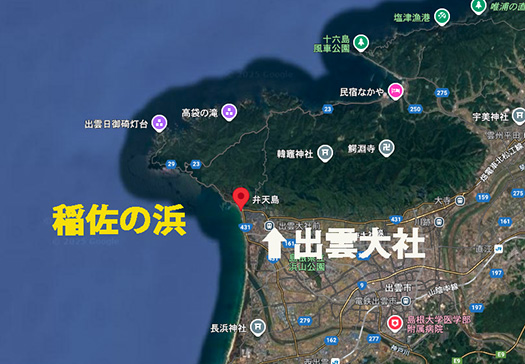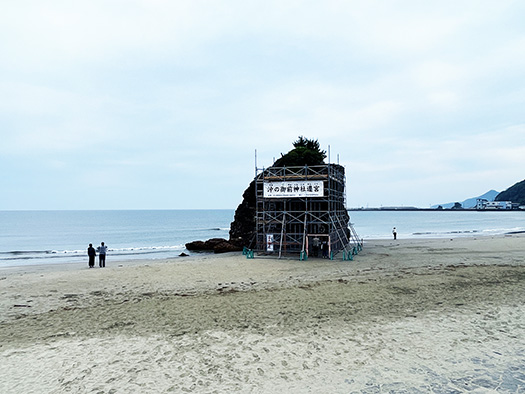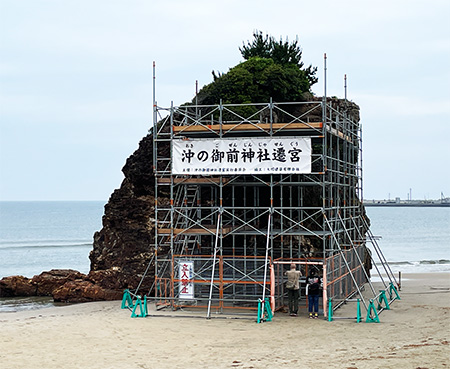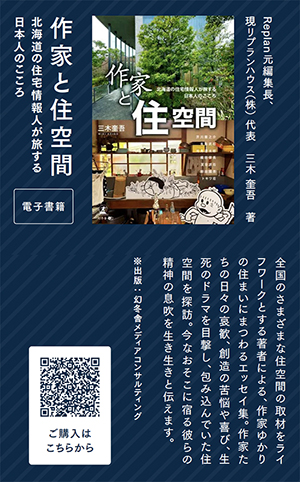


さて本日、山陰への旅の「体験まとめ」シリーズに回帰。
結局、古事記に書かれている出雲古代王権のことがさまざまに想起されて来ざるを得ない。わたしたちは日本史を学ぶとき、おおむね正史として学習するのはヤマト王権による全国支配、それも大化の改新を起点として政治史が始まるような正史の流れのように思う。いわゆる乙巳の変によって蘇我氏の専横が排撃されて天皇家による権力集中が開始されて古代国家が成立していった、という理解。
しかしそれは歴史学者さんたちの共通認識がそれ以降が「事実認定」しやすい、というような事情が反映したものだということが一般的に広く受け止められている。
大化の改新以前にも当然ながら、多くの政治闘争は繰り広げられていたことは自明。
そういった歴史プロセスの中で「国譲り」という結節点は、神話という表現で残されてきているのは、明白なのではないかと思われる。そんなことから、カミさんがわたしの「数寄」に配慮して訪問先の旅程に組み込んでくれていたのが、出雲大社社殿からほぼ1kmほどと近接するこの稲佐の浜・沖御前神社。
伝承では、出雲の主宰者であったオオクニヌシに対して鹿島神宮に祀られている「タケミカズチ」と香取神宮に祀られる「フツヌシ」がこの浜辺で「国譲り」を迫ったとされている。オオクニヌシはその脅迫に対して息子たちの同意が得られれば、と承諾の返答をしたとされている。
神話世界的にはアマテラス系の神々が、スサノオ系の出自譚を持つオオクニヌシに禅譲を迫ったということのクライマックスのように表現されている。
高校〜大学時代には新左翼運動に近しく唯物史観的志向性の人間ですが、人生のながい月日を過ごしてきて、どうもこうした神話に民族の「ある種の」整合性があるように思えてきている。日本歴史についての古事記の表現に対し、それをしっかり探査することが重要なのではないかと思う。現地で見たのは現代建築技術での再生工事の様子でしたが、神話に対してリスペクトしつつ、その実相を解明する姿勢のように感じられて、なにか共感できると思っておりました。
●お知らせ
拙書「作家と住空間」幻冬舎から電子書籍で発刊
お求めはAmazonで。
https://amzn.asia/d/eUiv9yO

English version⬇
The ancient Izumo “Yuzuru” shrine at Inasa-no-hama and Okigozen Shrine is under construction.
We would like to see the Kojiki re-examined as an intellectual asset of the Japanese people against the postwar “predetermined” view of ancient Japanese history that places the highest priority on materialistic historical perspectives. I would like to see the Kojiki re-examined as an intellectual asset of the Japanese people.
Today, we return to the “Summary of Experiences” series of our trip to the San’in region.
In the end, we cannot help but be reminded of the ancient Izumo royalty described in the Kojiki in various ways. When we study Japanese history, we generally learn about the rule of the Yamato kingdom over the whole country, and the political history of Japan begins with the Taika Reform of the Taika Era. It is understood that the so-called “Otomi Incident” eliminated the tyranny of the Soga clan and initiated the concentration of power by the emperor, thereby establishing the ancient state.
However, it is generally accepted that the common understanding among historians reflects the fact that it is easier to “recognize the facts” after the Taika Reformation.
It is obvious that many political struggles had been waged before the Taika Reformation.
It seems obvious that in such a historical process, the nodal point of “handing over the country” has been left behind in the form of a myth. For this reason, my wife included Inasa-no-hama and Okigozen Shrine in our itinerary of places to visit, taking into consideration my “several requests” to visit.
According to legend, Takemikazuchi, enshrined at the Kashima Shrine, and Futsunushi, enshrined at the Katori Shrine, threatened to “hand over the land” to Okuninushi, the leader of Izumo, on this beach. Okuninushi is said to have responded to the threat by agreeing to do so if his sons agreed.
In the mythological world, the story is described as the climax of the Amaterasu line of gods pressing Okuninushi, who has a tale of Susanoo origins, to give up his Zen.
I am a person with a materialistic historical orientation who was close to the New Leftist movement during my high school and college years, but after spending many months of my life, I have come to believe that there is “some” kind of consistency in these myths about the people. I think it is important to explore the ancient representations of Japanese history. What I saw at the site was a revitalization work using modern construction techniques, and I thought I could sympathize with their attitude of respecting the myths while trying to clarify the reality of them.
●Notice
My book “The Writer and the Residential Space” is published by Gentosha in e-book format
Available at Amazon.
Posted on 7月 2nd, 2025 by 三木 奎吾
Filed under: 歴史探訪







コメントを投稿
「※誹謗中傷や、悪意のある書き込み、営利目的などのコメントを防ぐために、投稿された全てのコメントは一時的に保留されますのでご了承ください。」
You must be logged in to post a comment.